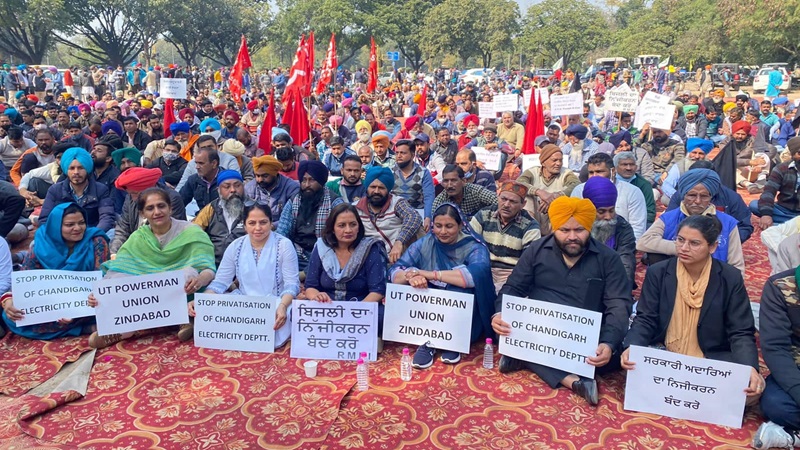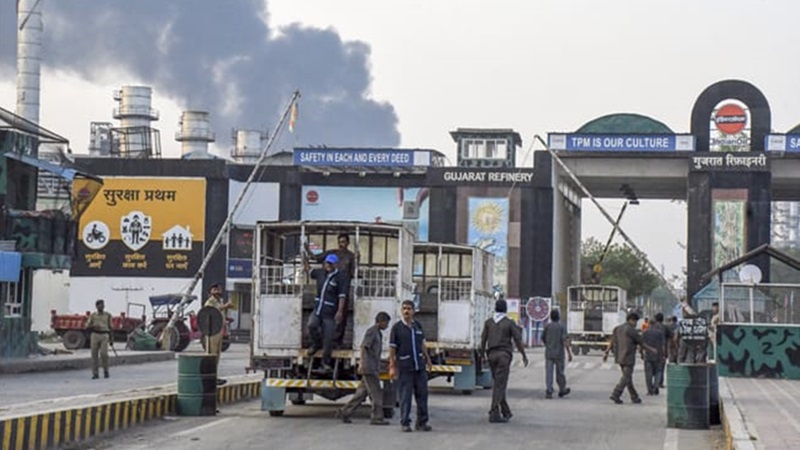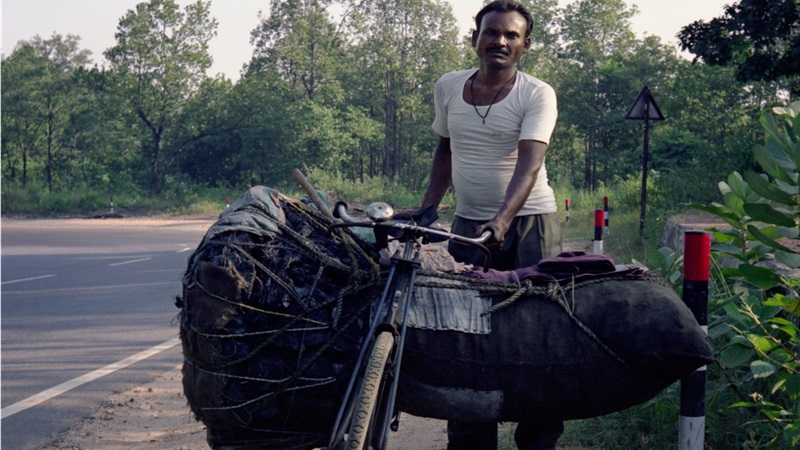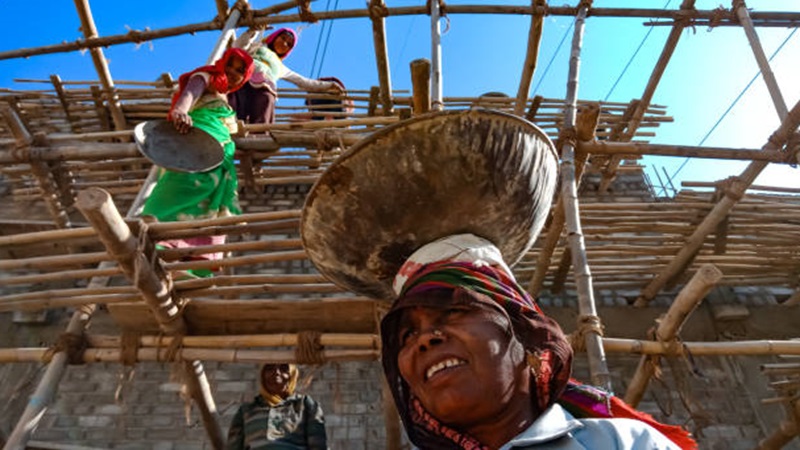Textile town of Tirupur, story of suicides and slavery – A fact find report
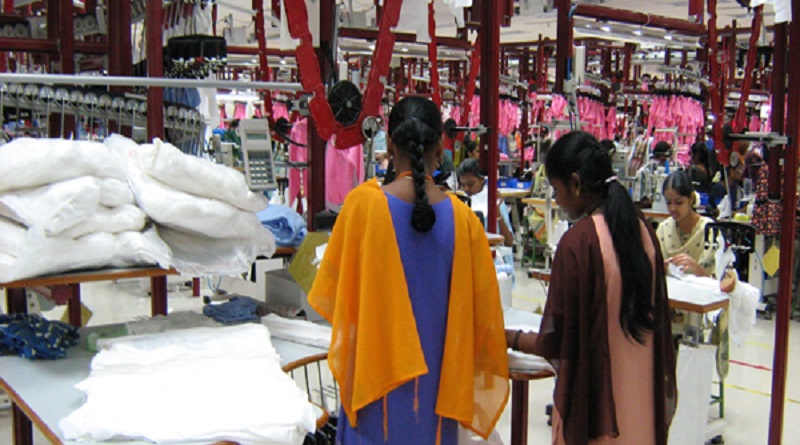
The Tirupur Report was prepared by a group of Delhi students, and presented at a discussion meeting held in Gandhi Peace Foundation, New Delhi on 22 May, 2011
(Following reports of suicides of workers of Tirupur we formed a ‘Committee Of Concerned Citizen-Students n Youth’ and sent a ‘fact finding team’ to Tirupur in Tamil Nadu in March. Here are its observations.)
The reports of workers suicides from Tirupur were unconscionable. Here was this boom town in Tamil Nadu spinning, knitting and tailoring its way to prosperity and amid all this there were the suicide stories. Here was a truly globalized workplace which supplied apparel to all the big global brands – Walmart, C&A, Diesel, FILA, Reebok et al. It wasn’t a place where cotton had failed and the cotton producing farmers with no way to fend themselves had committed suicide as in Vidarbha. Here cotton was gold. With exports touching 12000 crore rupees and more, fortune dogged the heels of Tirupur. Here was a town showing us what entrepreneurship meant. What was a small hosiery, mainly undergarment, manufacturing centre in the 1970s went on to become a leading exporter of garments in the globalizing decades setting a scorching developmental pace. Suicides at such a place were a baffling phenomenon.
The reports were really disconcerting and we thought that we must have a look at the state of affairs in Tirupur. We talked to workers, union leaders belonging to CITU and AITUC and social activists. We went through the reports in the magazines and newspapers. We also went through the reports of various government departments and NGOs and we have also drawn upon them in our report. Here is the tragic story which we gathered.
More than 800 workers have committed suicide in the last two years and the new district of Tirupur witnesses 20 suicide attempts everyday! The workers of the textiles units of Tirupur were committing suicides and such a mass phenomenon could not but be the result of the conditions under which the working class of Tirupur worked and lived.
Innovative Labour Practices –
The Tirupur entrepreneurs are really enterprising and no wonder they are so innovative in their labour practices. They know how to maximise their surplus and have come up with such systems of retaining and exploiting labour like the ‘sumangali’ and ‘camp-coolie’ systems.
The Sumangali system is meant for girls of marriageable age. It is a system which effectively draws upon the marriage practices in Tamil society by seemingly addressing the fears and concerns of parents of young girls. These girls generally come from South Tamil Nadu villages. Gender discrimination effectively provides the entrepreneurs with fodder for exploitation. Adolescent girls are employed as workers on a 3-year contract. At the end of the contract period they are paid a lumpsum amount varying from Rs.30000 to Rs.60000 which is seemingly meant for their marriage and dowry. According to reports even this is denied if there is any break in service due to illness or leave. These girls are provided with boarding and lodging. They are confined to their hostels and only those family members whose photographs have been supplied to the factory management are allowed to meet them. This confinement has a deleterious effect on their psyche.
On top of it their food is poor and living conditions unhygienic and bad. They have to work extra hours and that too without payment. There are many occupational hazards in cotton spinning and garment industry like respiratory problems, tuberculosis, abdominal pain and giddiness. Along with the unwholesome living conditions these go to aggravate their health problems. To make matters worse these girls are sexually exploited too. Labour laws are followed here in the breach. The girls working as Sumangalis are classified as either trainees or apprentices. As such most of the labour laws do not apply to them and on top of it they are not entitled to the wage rates for regular workers. They are at the mercy of the factory management. The female workers face a double exploitation as workers and as females. This oppressive regime has been arraigned in various reports and the courts have also censured the system as being illegal. A petition was filed by the trade unions against this practice in the Chennai High Court which observed ” we are satisfied that the “camp coolie system” which is also known as “Thirumangalam Thiruman Thittam” and ‘Sumangali marriage scheme’ is per se illegal and amounts to bonded labour and the authorities are bound to take steps to abolish the system and regularise the services of the female workers working under the ‘camp coolie system’ and to ensure that they receive wages as per the law throughout.” It goes without saying that all this is in vain. All the same manufacturers vehemently deny the practice of the ‘Sumangali’ system. A change of nomenclature has also been effected to this end and is called “training scheme for fresher”.
It may be mentioned that when we say innovative labour practices we really mean it in the sense that the manufacturers here have come up with novel systems to contravene the law, maximise their surplus and compete in the world market through such exploitation of cheap labour. Consider the process of change that led to this system. The Sumangali system is mainly found in the spinning mills. In the past these mills employed male labour. In the 1970s as a result of industrial action these workers became “permanent” with all the benefits. To subvert the labour laws these spinning mills have largely changed over to this ‘sumangali’ system of employing adolescent girls.
The changes in the requirements has also led to the camp coolie system which again reminds us of the methods to prevent high turnover of labour and ensure a smooth supply of labour for round-the clock running of the factories.
Migrant Workers as Camp Coolies –
Cheap labour from Bihar, Orissa, Rajasthan and Jharkhand are brought by the labour contractors. These labour contractors keep an eye on their folks and the managements deal with these workers through them. We met many such workers at the gates during tiffin time. We were rather surprised at the fact that the workers were forthcoming and talked about their woes. One worker, who gave his name as Munna, worked in a garment factory and had come all the way from Sitamarhi in Bihar. He had been brought here by the labour contractor. He lived in a dormitory provided by the factory owner along with other workers. The hostel was far away from town he complained. These migrant workers who stayed in hostels were unapproachable to the unions. It reminded us of the fact that only the workers from Tamil Nadu were unionised. About 10 percent of the near 4 lakh workforce of Tirupur were members of unions. He stayed single here and said that none of the workers in his hostel lived with his family. He had to work for 12 hours daily. He had a six-day week with Sunday being a holiday. However if orders had to be completed he had to work on Sundays too without extra payment. He was a tailor and that meant his job was a upper-end one and he reported a wage of about Rs. 1710 per week. He was entitled to no other benefit. He was 21 years old and was aware of the temporary nature of his job.
He said that none of his fellow workers had the benefits of PF, ESI etc.. They were not members of any union and the labour contractor mediated on their behalf. Being migrant workers they felt vulnerable and remained docile. The camp coolie system surely has its benefits for the owners by making the workers accessible to them and inaccessible to union workers. They are forced to live a life of total isolation from larger society and their life is a perpetual sacrifice at the altar of capital.
Sacrifice at the altar of capital
With such low wages, no social security and health facilities, no employment benefits like PF, ESI etc. and great intensity of work the life of the workers becomes a burden. Living conditions are abysmal with crowded rooms, poor sanitation and high cost of living. (Tirupur is one of the costliest towns in India. It is estimated that it is costlier than Banglore.) With such a burdensome life the workers take recourse to heavy drinking. Kovai Sathasivam, the documentary filmmaker, told us that liquor shops in Tirupur reported sales of Rs. 5 crores on Saturdays. This situation leads to a vicious circle where to make ends meet the workers borrow from moneylenders. Unable to bear such a beastly life workers face severe psychological problems leading to such high rates of suicides. Tamil workers who come here from their villages to make ends meet, pay back high interest debts, meet family obligations find that they have been duped. The presence of usury (kanduvatti) shows the abysmal wages and living-working condition of the workers.
We saw the wretched and stressful conditions under which the girls (‘sumangalis’) live and work. This accounts for a very high incidence of attempts to suicide among them. Adolescence is a period specially prone to mood changes and with confinement, overwork and such exploitation suicide attempts are a tragic consequence. It is a severe indictment of the state of affairs in the Tirupur garment industry. Officially the suicides may be attributed to family quarrels or drinking but at the root of it lies a life of grinding poverty and overwork. Indeed life is a burden for them. To illustrate —
“Meanwhile, lying limp in her hospital bed, Maratakavalli explains that if her husband hadn’t faced financial problems, and if the couple had enough time to spend together, she might have never contemplated suicide. “But both of us work for different companies from 9 am to 10 in the night,” she says. “By the time we reach our rented room, we are too tired. We were struggling to make both ends meet. My husband ended up torturing me to escape his wretchedness.” (Frontline; Sep. 25-Oct. 08, 2010 )
The success of Tirupur comes from the spoliation of the workers. The living and working conditions of the workers of Tirupur garment industry take a heavy toll of their lives. The workers are not only subjected to the occupational hazards of the industry the intense work exacted from them leads to burnouts at an early age. For instance tailoring, which compels intense attention from the workers, leads to early burnouts and it is said that it would be difficult to find tailors above 40 years of age here. They are nothing but beasts of burden as it were – only so much fodder for capital. Torn out of their homes and hearths they are here flung into hostels which act as dungeons where their activities are effectively monitored by the manufacturers. Tirupur takes advantage of large-scale uprooting of populations from other Indian states which ensures a perpetual source of cheap labour for them.
Capital demurs !
Commenting on the use of cheap labour by Tirupur manufacturers M. Vijayabaskar, Assistant Professor, Madras Institute of Development Studies said “Cost-cutting measures assumed great importance in the competitive global market, particularly in the post-MFA era.” [The multi-fibre agreement imposed quotas on exports by developing countries to developed countries. It was in force from 1974 to 2004 end.] “As manufacturers could not do much about cutting the cost of power or transportation or controlling foreign exchange fluctuations, they tinkered with the wages of workers by adopting methods such as the camp coolie system. Under this, workers were accommodated in hostels and dormitories and did not have to be paid the same salary as those who came under the purview of the wage accord reached with the trade unions, said M.Vijayabaskar,.” (Frontline, Sep. 25-Oct. 08, 2010)
The only cost cutting that can be done is in the sphere of labour costs. This fact shows the inherent inequities of the wages system. It is not a fair contract between the buyer, the capitalist and the seller of labour power, the worker. It is a class relation of capital and labour and an inherently unequal one in which all of labour’s disadvantages can be taken advantage of. So not only cheap labour but labour put in extremely onerous conditions such as camp-coolies and sumangalis. It reminds us of the infamies of the cottage system and truck system found in capitalist England and arraigned by Engels in his The Condition of the Working-Class in England.
Intense work, long working hours, unhygienic living-working conditions, prison like confinement leading to burnouts and suicides shows that the capitalists are still carrying on with what Marx called their experiments in corpore vili (Capital I, p.462, PP, Moscow). He noted in his magnum opus, Capital – ” (Hence) Capital is reckless of the health or length of life of the labourer, unless under compulsion from society. To the outcry as to the physical and mental degradation, the premature death, the torture of over-work, it answers: Ought these to trouble us since they increase our profits?”(Capital vol. I, p.257)
This is the spirit of capital and it tends to this brutal level unless compelled by society. Today with the new worldwide assault of capital on the working class in the form of globalisation it is a race to the bottom for every country particularly the backward ones. Though of course we also find the presence of sweatshop labour in the USA and its prison industrial complex approximates such brutal conditions.. The entrepreneurs of Tirupur are indeed innovative in their efforts to make an ass of the law and subvert any labour protection law. Still, they are not satisfied and carry on their tirade against the labour laws and call for flexible labour laws –
“But the manufacturers are not satisfied with such arrangements. They have launched a sustained campaign for “flexibility in working hours in the form of more overtime per calendar quarter in view of the seasonal nature of the industry and the high dependence on export orders”. Claiming that the labour laws in India are “quite inflexible and rigid”, they have asked the Central government to “liberalise labour laws since the existing rules and regulations are constraints to the overall growth of the textile industry”. They raised the issue forcefully at the meeting of the Industrial Tripartite Committee on Cotton Textile Industry held in New Delhi on July 15.”( Frontline Volume 27 – Sep. 25- Oct. 08, 2010)
Not satisfied with confining workers in hostels out of the reach of unions, union busting and subverting the labour laws the manufacturers bring up the pressure on the government and ensure that no labour laws come up on the way of super-exploitation of labour. The Tirupur garment industry rides on the wave of relocation of such labour intensive industry to the backward countries. Its cry for socalled flexible labour laws, laws that allow maximum leeway to the manufacturers in the name of growth shows its hunger for profits by experiments in corpore vili. That the existing labour laws do not constrain growth is testified by the report of the National Commission for Enterprises in the Unorganised Sector.
“Decline and increase in employment has, in fact, been found to have taken place primarily on considerations of market and technology (Papola 1994, 2008, Kannan and Raveendran 2009). The real cause of slowdown or decline in employment growth in organised manufacturing, thus, seems to lie in market conditions for products of individual industries, and not in restrictive labour laws.” (Challenge of Employment in India, Vol. 1)
The deceleration in the garment industry following recession validates the Commission’s view that growth (and employment growth in consequence) primarily depends on market conditions. The NCEUS in its report has debunked the call for such flexible labour laws in the name of growth of employment and industry.
To the charge against the bad condition of the workers Arumugam Sakthivel, President of the Tirupur Exporters’ Association has this to say —
““The workers are happy and well-paid. If they are not happy with one company, they are free to work for another as in Tirupur, we have no shortage of textile companies.”
What we find in this statement is flat denial, lies and the implicit threat of dismissal – “free to work for another”. This “free to work for another” is indeed a feature of capitalism. Wage slaves are not bound to any one capitalist but to the capitalist class as a whole. Marx called wage labour mediated forced labour (Grundrisse, p.251, ME CW 28). If the living and working conditions in Tirupur are such this freedom does not count for much. Actually the freedom of the worker is to either accept such conditions or starve. Sakhthivel’s words are hardly of much comfort in real life for their poverty and helplessness makes them prey to all the depredations of capital. Commenting on a description of the slave system of the nineteenth Marx commented –
” Mutato nomine de te fabula narratur [Change the name and the story relates to you]. For slave-trade read labour-market, for Kentucky and Virginia, Ireland and the agricultural districts of England, Scotland, and Wales, for Africa, Germany. We heard how over-work thinned the ranks of the bakers in London. Nevertheless, the London labour-market is always over-stocked with German and other candidates for death in the bakeries.”
Today the whole of India is over-stocked with migrant workers who are game for the greed of the capitalists. The oversupply of labour fulfils the conditions for executing orders given at short notice. A study done by the Centre for Education and Communication (CEC) on Tirupur quotes a former manager from BB exporters:
“They give very short period to complete an order. We had to struggle a lot to meet the deadlines. Generally the lead time would be three months. If we send the sample they will take time to approve it, but once it is approved they will give us a brief period to complete the order. We cannot do it with our own capacity even though we have all facilities and thousands of workers. We need to outsource to independent units.”
These small units execute the orders by using casual labour. The need for such a supply of labour can only be fulfilled because of migrant labourers in search of work who can be hired and fired at will according to the market requirements.
They are a perennial source of cheap labour for the bourgeoisie and work is extracted from them under the most oppressive conditions. The law of the land takes a very stringent view of this as we have seen above. The majority of the Tirupur workers would come under the category of forced labour as per the laws of the land.
In the Asiad workers case Supreme Court order (AIR 1982, SC 1473) the Supreme Court held that the word forced must be construed to include not only physical or legal force but also force arising from the compulsions of social and economic circumstances, which leave no choice or alternatives to a person in want and compels him to provide labour or service even though the remuneration received for it is less than the minimum wage, which clearly falls within the concept of forced labour under Article 23 of the Constitution. (From the Fair Wear Foundation Report on Tirupur) Such a view puts the majority of the workers under that category whether they are contract workers in modern steel mills or home workers. Even the government violates the law in the case of NREGA by claiming that wages are governed by Section 6(1) of the act and it is immune from the Minimum Wages Act! The Supreme Court and High Courts may pass judgments but the harsh reality is different. The report of the MSSRF and the World Food Programme on food security put the matter in these terms –
” The nature of the Indian State in terms of its political economy has been a key factor in its failure to implement its oft-declared pro-poor commitments” ((Report on the State of Food Insecurity in Rural India, Dec. 2008)
That brings us to the larger questions of India’s political economy.
Labour supply, cheap labour and the Indian economy
The Tirupur manufacturers have carved a niche for themselves on the strength of cheap and abundant labour. Exports gained momentum in the late eighties and Tirupur came into its own in the globalised environment of the nineties.
India’s game plan to compete in the globalised environment is based on our “asset” of cheap labour. Montek Singh Ahluwalia, the champion of neo-liberal economics and the deputy chairman of the planning commission went on record recently expressing the desire to replace China as a manufacturer and exporter of textiles and leather on the strength of cheap labour. The newspapers of April 21, 2011 reported him as saying – “the Chinese will be vacating the lower end of value spectrum like textiles and leather. So who will replace them? Are we going to step in or will it be Vietnam or Turkey or Indonesia?’’ and he added that Indian exports would be more competitive as wages increase in China which was to end its policy of export-oriented growth. This is India in the globalised workplace benefitting from cheap labour. At Tirupur this might mean a higher suicide rate but that hardly is any deterrent for the powers that be. That brings us to the larger question of the Indian economy.
Among other things imperialist globalisation meant the vacation of the “lower end of the value spectrum” to the backward and poor countries. Not only that it also meant that there would be relocation of industries from the advanced capitalist countries to countries with lower wages. It meant that the imperialist countries would become more parasitic. So apart from the “lower end of the value spectrum” the “upper end” like auto OEM and automobile manufacturing also shifted to backward countries like Brazil, Mexico and India. Detroit in the US no longer remains the symbol of auto manufacturing like it was. So we find Manesar and Tirupur hogging the headlines for being at the forefront of growth and working class troubles both. If Manesar in Gurgaon is restless, the workers are on the boil every now and then, the working class of Tirupur shows the hideous face of globalisation with suicides. What lies behind the scorching pace of growth at 8 to 9 percent per year is the sacrifice of the workers. Even in the organised sector we find that most of the jobs have been created in the informal sector, i.e. insecure, low-paid jobs. Here is what the NCEUS has to say in its report –
“This universe of informal workers now constitutes 92 percent of the total workforce. We have also highlighted, based on an empirical measurement, the high congruence between this segment of the workforce and 77 percent of the population with a per capita daily consumption of up to Rs. 20 (in 2004-05) whom we have called “Poor and Vulnerable”. The number of persons belonging to this group increased from 811 million in 1999-00 to 836 million in 2004-05. On the employment front, the low rate of growth during 1993-94 and 1999-00 gave way to a higher growth rate of employment during 1999-00 to 2004-05. But the additional employment created during this period was entirely informal, whether in the unorganised or organised sector.”
This is the stark picture of poverty and employment provided by a government commission. Yet we find the policy of the government is to promote informalisation aided by flexible labour laws and cheap labour costs. This can be gleaned from various government reports and the reality conforms to it. Whether it be the new areas of growth of commodities like automobiles and auto original equipment (Manesar) or old ones like Tirupur making it big all have benefitted from cheap labour and almost non-existent labour laws.
The Indian economy works to churn out the vendors of cheap labour. For instance, it is estimated that between 1991 and 2001 about 3.3 crore (33 million) farmers have lost their land and entered the ranks of landless and migrant labour (Alternative Economic Survey, 2005-06 p. 46). In the villages today wage work is the principal source of income for the majority [1]. The Indian economy entered the 21st century with abundant supply of cheap migrant labour! It is this expropriation going on in this economy which lets the articles of faith of neo-liberalism work smoothly – cheap labour, contract labour and flexible labour laws. Workers can be summoned for great works and dismissed soon after completion — witness the eviction of workers from Delhi immediately after completion of the construction of the Commonwealth Games infrastructure. This is a story of expropriation and grinding poverty, of helplessness and silent displacement taking place all over India, one which doesn’t appear to rattle our collective conscience like the SEZ displacement does. It appears natural for it is not the circumstances of force that brings this about but the force of circumstances. Not the brutal hand of the Indian state but the ‘invisible hand’ of Adam Smith brings this about. The enormity of the phenomenon gets explained in the rather innocuous sounding ‘push’ and ‘pull’ factors of esoteric textbook economics. Only when a Tirupur happens that we are forced to look at this capitalist expropriation.
This is achieved by the spontaneous processes of capitalism and is ably aided by the neo-liberal policies as noted by various studies. Of course when we say this we must be careful for there is a whole breed of economists who breathe fire against neo-liberal capitalism only. We should remember that neo-liberal capitalism is capitalism and the Indian economy has been a poverty stricken one even before the neo-liberal policies came into vogue in the 90s of the last century.
Resistance movements have been successful in thwarting forced expropriation as in Nandigram. To achieve success in thwarting the expropriation of the toiling masses from land, their displacement from home and hearth would mean thwarting the invisible hand of Adam Smith. This can only be achieved by overthrow of the present capitalist system whose spontaneous processes bring this about. By making us ponder at the whole gamut of economic processes the Tirupur suicides make this thing clear. Today efforts are being made by certain quarters, mainly by the NGOs, the capitalists and the government to remedy affairs by forming partnerships and incorporating the working class too in it – in the name of being stakeholders! (A Tirupur Stakeholders Forum has been formed following the reports of suicides). In the name of fighting forced labour there is an attempt to prettify wage slavery and capitalism. The working class has no stake in this economy and finds itself at the receiving end of all that is wrong. So while entrepreneurs pride themselves on Tirupur becoming a 11,500 crore rupee export hub the workers slog it out and kill themselves in despair.
It is the same with the country – while 77 percent of its citizens make do with less than 20 rupees per day India’s per capita income is Rs. 54,527 (in 2010-11; at current prices). There are 55 dollar billionaires in India today. Amidst such wealth we have grinding poverty. As the report quoted above admits the character of the present state makes it near impossible to implement its so-called propoor commitments. How can the working class be a stakeholder within such a state? The pronouncements of even the higher courts of the land mean nothing. What can we expect in such a state? The whole situation calls for a revolutionary reconstitution of society born out of the class struggle of the working class against the rule of capital.
(We are specially thankful to our young friend S.Balachandran of Coimbatore who helped us by acting as our Tamil interpreter)
Notes
As pointed out by this Commission, at all India level, more than 80 per cent of the farmers belong to marginal and small farm size groups, owning or operating less than 2 hectares of land. The percentage of marginal and small farmers in the total, and also the land operated by them has steadily increased over time. The percentage of marginal farmers has gone up from nearly 38 per cent in 1953-54 to about 70 per cent in 2002-03. As per the Farmer’s Survey,, 54 per cent income is from wage income and only 26 per cent is from cultivation among the marginal farmer households(owning less than 1 ha of land). The share of income from animal farming (5.5 per cent) is also the highest for this category of farmers. Among small farmers, 56 per cent of the income is from cultivation while 30 per cent is from wages [Challenge of Employment in India, Vol. 1, National Commission on Enterprises in the Unorganised Sector, p.247]
(This report is publish in Sanhati website on 18 June 2011.)
